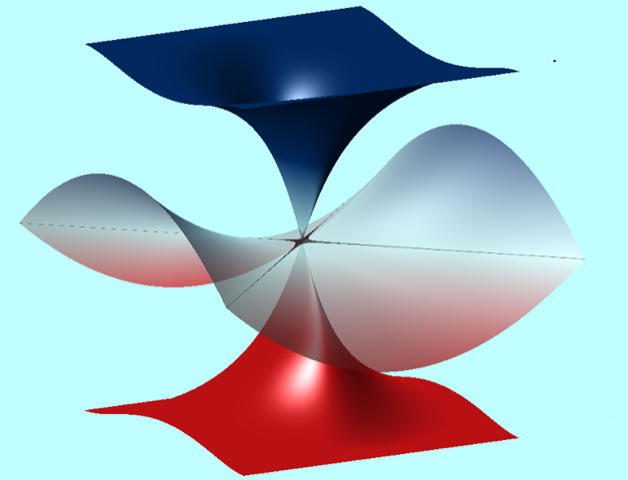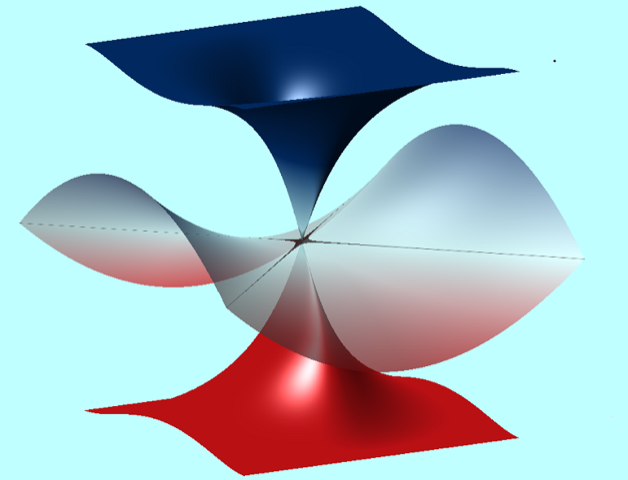A Whole Surface of Exceptional Points
One of the fundamental laws of physics is that energy is conserved, but many local physical systems—seen in isolation—gain or lose energy. For example, a light bulb converts electrical power into radiation, which from the perspective of the electrical circuit is a loss of energy. By contrast, a light beam gains energy as it passes through an amplifying medium. Although one can model the inputs and outputs, it’s often mathematically simpler to just treat energy as a locally nonconserved quantity. Nonconservative systems, referred to as non-Hermitian, have attracted a great deal of interest because they can exhibit potentially useful phenomena, such as enhanced sensing [1] and robust single-mode lasing [2]. These phenomena are intimately related to the ability of non-Hermitian systems to support exceptional points, a type of degeneracy in which two or more modes suddenly coalesce into one (Fig. 1). However, a common difficulty is finding a robust set of parameters to form the exceptional point. To help make that job potentially easier, Xufeng Zhang and co-workers at Argonne National Laboratory in Illinois have now demonstrated a system that has not just one exceptional point but a whole collection of points in a two-dimensional parameter space [3]. This “exceptional surface” is an exciting achievement, as it offers a robust platform for realizing the unique phenomena associated with non-Hermitian physics.
Across many fields of physics, non-Hermitian mathematical functions, or operators, are used to model nonconservative properties, such as finite lifetimes, dephasing, and open system boundaries. These non-Hermitian operators simplify calculations by allowing a mathematical model to focus on the system of interest, without the need to consider additional degrees of freedom to represent energy exchange with the environment. An example of the utility of these operators is found in the calculation of the lasing threshold of a cavity, which depends upon the rate at which the field is amplified through stimulated emission and the rate at which photons are emitted from the cavity, but it is agnostic to the exact details of both of those processes.
Although non-Hermitian operators have been used in physics for decades, a pioneering work was published in 1998 by Carl Bender and Stefan Boettcher [4], who realized that certain non-Hermitian operators—those that obey parity-time symmetry—could yield physically observable quantities in quantum-mechanical systems, a distinction previously reserved only for Hermitian operators. This discovery renewed interest in uniquely non-Hermitian phenomena, particularly in the field of photonics [5]. After some initial photonic experiments verified Bender and Boettcher’s claims [6], the focus on non-Hermitian photonics shifted to identifying new capabilities and applications. Many of these new phenomena require an exceptional point, which is a location in the system’s parameter space where some or all of the modes collapse into a single mode, and the system effectively loses one or more dimensions. Much of the effort in experimental studies has been devoted to finding systems that exhibit exceptional points that are robust against fabrication imperfections.
Zhang and colleagues have developed a new experimental platform for realizing exceptional points in a so-called magnon polariton system [3]. Their system consists of a photonic cavity containing a 400- 𝜇m-wide sphere of yttrium iron garnet (YIG), which is known to host collective spin excitations (whose quanta are called magnons). The team applies an external magnetic field, which couples the cavity’s photons to the sphere’s magnons through magnetic dipole interactions. The system is non-Hermitian because energy in the electromagnetic field is constantly dissipated by absorption into the cavity walls, and the YIG spins dissipate energy through relaxation. Moreover, the dissipation rates in the cavity and in the YIG sphere are separated by over an order of magnitude, which aids in the formation of exceptional points.
The unique feature of the team’s magnon polariton system is that it admits four degrees of freedom, two of which are related to the location of the YIG sphere within the photonic cavity, and two of which are the strength and direction of the applied magnetic field. For a particular sphere position and magnetic field setting, the team observes the modes in the coupled system by measuring the reflectance of the cavity. Normally, they detect two modes, but as they move the sphere, for example, the modes can coalesce into one—signifying an exceptional point. If the magnetic field is slightly reoriented, the team is able to find another exceptional point not far away by retuning the position of the sphere. This means that the magnon polariton system can realize a continuous two-dimensional surface of exceptional points in their four-dimensional system.
Previous work had realized one-dimensional lines or rings of exceptional points [7], but this is the first demonstration of a two-dimensional sheet of exceptional points. Such an exceptional surface is highly desirable for possible enhanced sensing applications [8]. How is it possible that exotic non-Hermitian systems play a role in sensor development? Consider that in a regular (Hermitian) system, a small perturbation will only change the observed output by a small amount that scales linearly with the perturbation size, Δ. However, this limitation does not hold for non-Hermitian systems. In particular, near an exceptional point, the scaling goes as the Nth root of the perturbation, Δ1∕N, where N is the number of modes collapsing into the exceptional point. As a result, a non-Hermitian system will be more sensitive than a Hermitian system to, say, a small change in the external magnetic field or the resonance frequency of the photonic cavity [1]. Having a whole surface of exceptional points would make a non-Hermitian sensor more valuable, as it presumably could be responsive to a wide range of inputs and would allow for greater tolerance from fabrication imperfections.
However, there is some controversy over whether it is possible to enhance the sensitivity of a measurement by operating a system near an exceptional point. Theorists have put forth two counterarguments. The first is that detectors do not directly measure the mode outputs but instead measure system quantities, like a cavity’s reflectance, that are only indirectly related to the mode values and may not experience this increased sensitivity. The second is that the increased noise in these nonconservative systems removes any potential benefits of the exceptional point. It therefore remains to be seen whether a non-Hermitian system can be constructed to realize this potential increase in sensitivity [9].
Nevertheless, exceptional points remain an active research field. Possibly the most exciting new direction for future research is in combining non-Hermitian photonics with topological insulators and other lattices with topological properties [7, 10]. While these efforts serve a practical purpose in mitigating the effects of fabrication imperfections in topological photonics structures, they have also uncovered some striking new phenomena, such as new types of lasers and a new method for routing a signal through a topological insulator. Here though, many open questions remain, as it is not known whether one can define topological invariants in non-Hermitian systems in the same way as done in Hermitian topological lattices. It’s clear that no energy would be wasted in further studying systems that “violate” energy conservation.
This research is published in Physical Review Letters.
References
- W. Chen, Ş. K. Özdemir, G. Zhao, J. Wiersig, and L. Yang, “Exceptional points enhance sensing in an optical microcavity,” Nature 548, 192 (2017); H. Hodaei, A. U. Hassan, S. Wittek, H. Garcia-Gracia, R. El-Ganainy, D. N. Christodoulides, and M. Khajavikhan, “Enhanced sensitivity at higher-order exceptional points,” 548, 187 (2017).
- L. Feng, Z. J. Wong, R.-M. Ma, Y. Wang, and X. Zhang, “Single-mode laser by parity-time symmetry breaking,” Science 346, 972 (2014).
- X. Zhang, K. Ding, X. Zhou, J. Xu, and D. Jin, “Experimental observation of an exceptional surface in synthetic dimensions with magnon polaritons,” Phys. Rev. Lett. 123, 237202 (2019).
- C. M. Bender and S. Boettcher, “Real spectra in non-Hermitian Hamiltonians having PT symmetry,” Phys. Rev. Lett. 80, 5243 (1998).
- K. G. Makris, R. El-Ganainy, D. N. Christodoulides, and Z. H. Musslimani, “Beam Dynamics in PT symmetric optical lattices,” Phys. Rev. Lett. 100, 103904 (2008).
- C. E. Rüter, K. G. Makris, R. El-Ganainy, D. N. Christodoulides, M. Segev, and D. Kip, “Observation of parity–time symmetry in optics,” Nat. Phys. 6, 192 (2010).
- B. Zhen, C. W. Hsu, Y. Igarashi, L. Lu, I. kaminer, A. Pick, S.-L. Chua, J. D. Joannopoulos, and M. Soljačić, “Spawning rings of exceptional points out of Dirac cones,” Nature 525, 354 (2015); A. Cerjan, S. Huang, M. Wang, K. P. Chen, Y. Chong, and M. C. Rechtsman, “Experimental realization of a Weyl exceptional ring,” Nat. Photon 13, 623 (2019).
- Q. Zhong, J. Ren, M. Khajavikhan, D. N. Christodoulides, Ş. K. Özdemir, and R. El-Ganainy, “Sensing with exceptional surfaces in order to combine sensitivity with robustness,” Phys. Rev. Lett. 122, 153902 (2019).
- H.-K. Lau and A. A. Clerk, “Fundamental limits and non-reciprocal approaches in non-Hermitian quantum sensing,” Nat. Commun. 9, 4320 (2018); M. Zhang, W. Sweeney, C. W. Hsu, L. Yang, A. D. Stone, and L. Jiang, “Quantum noise theory of exceptional point amplifying sensors,” Phys. Rev. Lett. 123, 180501 (2019).
- M. A. Bandres, S. Wittek, G. Harari, M. Parto, J. Ren, M. Segev, D. N. Christodoulides, and M. Khajavikhan, “Topological insulator laser: Experiments,” Science 359, eaar4005 (2018); H. Zhao, X. Qiao, T. Wu, B. Midya, S. Longhi, and L. Feng, “Non-Hermitian topological light steering,” 365, 1163 (2019).





